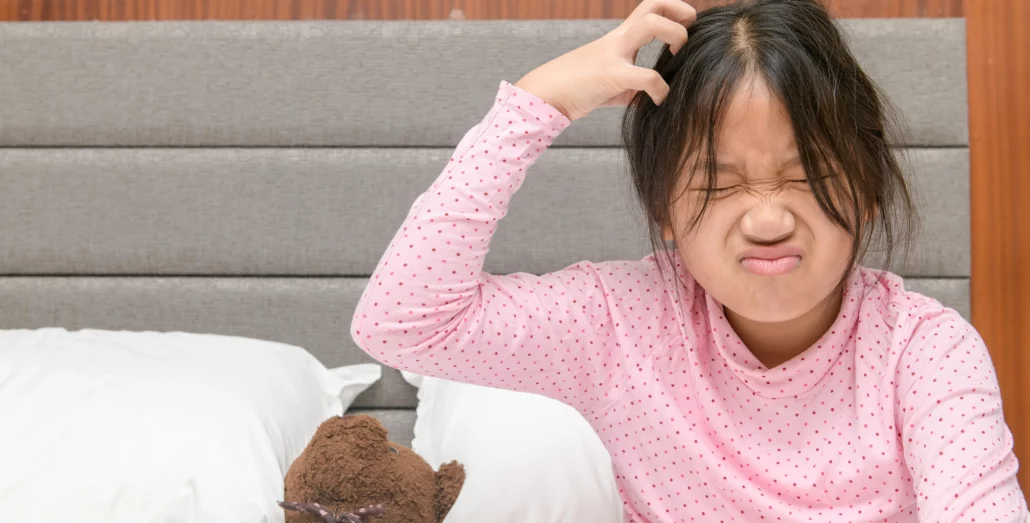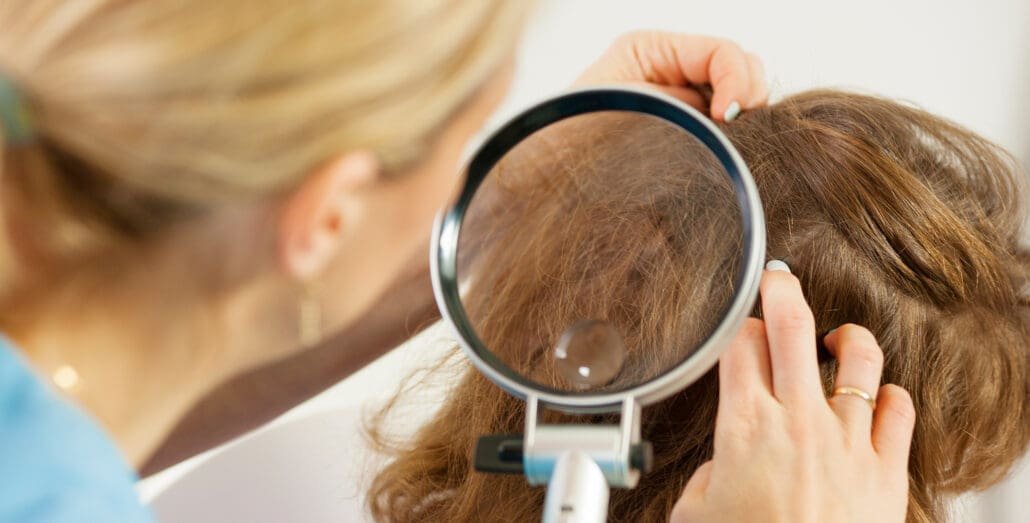Head lice can be a real nuisance. Not only can they cause intense itching and irritation, but they can also spread quickly through close contact with an infested person. But how can you tell if you have them? In this article, we’ll discuss the signs of head lice and how to know if you have an infestation. We’ll also cover how to get rid of these pesky critters, who is at risk for getting them, and when it’s time to seek professional help. So if those creepy crawlers are making your scalp their home, then read on for everything you need to know about head lice!
Lice: How To Tell if You Have Them
Head lice can be easy to miss, since the symptoms may not be immediately noticeable. But if you start to experience itching on your scalp, it’s important to check for signs of lice. These include an intense tickling sensation and small white nits (lice eggs) that look like dandruff but won’t brush away. You may also find crawling bugs or dark specks on your scalp, hairbrush, or clothing.
If you suspect you have head lice, you may want to get a professional head-screening right away as early detection can help prevent the spread of this contagious condition. With proper treatment and follow-up care, head lice can be easily managed and eliminated.
Who is at risk for getting head lice?

Head lice infestations can affect anyone, regardless of age, gender, or race. However, there are certain groups who may be more at risk than others. Children ages 3 to 11 are particularly prone to infestation, likely due to increased contact with other kids in school or daycare settings. Household members of children who have been diagnosed with lice also have an increased risk of getting an infestation.
Moreover, those with long hair and crowded living conditions may be more susceptible to an infestation as well. It’s important to keep in mind that head lice can spread quickly through direct contact and therefore it’s essential to take the necessary steps to prevent and treat an infestation if one occurs.
Can head lice be spread by sharing sports helmets or headphones?
Head lice are commonly spread through direct contact with an infested person’s hair, and in rare instances, through contact with inanimate objects such as hats, combs, brushes, or towels. While it is possible for head lice to spread through the sharing of sports helmets or headphones, it is highly unlikely.
Head lice have specially adapted claws that enable them to hold firmly onto human hair. This means that they would struggle to attach firmly to smooth surfaces like those found on sports helmets and headphones. Therefore, while it is not impossible for head lice to be spread through the sharing of these items, the risk is very low and should not be a cause for concern.
Can wigs or hair pieces spread lice?
The risk of head lice being spread through wigs or hair pieces is extremely small. Adult head lice can live only a day or so off the human head without blood for feeding, while nymphs (young head lice) can live only several hours without feeding on a human. Furthermore, nits (head lice eggs) are unlikely to hatch if they have not been properly incubating close to the human scalp.
Because of this, even if a wig or hairpiece has been worn within the past 48 hours by someone who is actively infested with live head lice, the chances of transmitting them are minimal. To ensure no transfer of head lice occurs when using wigs or hair pieces, it is important to keep them clean and store them properly in between uses.
Can swimming spread lice?
Swimming is not known to be a major factor in the spread of head lice. Data suggest that head lice can survive underwater for several hours, but are unlikely to be spread by the water in a swimming pool. Chlorine levels found in pool water do not kill head lice, and they may hold tightly to human hair and not let go when submerged.
However, it is possible for head lice to be spread through shared items such as towels or other items that have come into contact with an infested person’s hair, although this type of transmission is uncommon.
Do Kids Have to Stay Home From School?
Kids do not need to stay home from school if they have head lice. In the past, kids with head lice were kept home from school, but now doctors do not recommend this “no-nit” policy. Kids can stay at school until the end of the day and go home for treatment. However, it is important for them to avoid head-to-head contact with other kids while at school and to put long hair up in a bun, braid or ponytail.
After receiving treatment for their head lice, children should return to school. If worried about potential transmission of live head lice through swimming activities, children should be taught not to share towels or other personal items either at poolside or in the changing room. It is also important for parents to closely monitor their children for signs of lice infestation and seek medical advice if necessary.
What Are the Signs & Symptoms of Head Lice?

Head lice infestations are very common, particularly in children. It is important to be aware of the signs and symptoms of head lice in order to catch an infestation early and have it treated before it spreads.
The most common symptom of head lice is itching on the scalp or near the ears, which can be caused by an allergic reaction to lice saliva. Other symptoms include difficulty sleeping due to the itching, red bumps on the scalp, and a tickling feeling that something is moving around in the hair.
It is also possible to see live lice crawling on the scalp or within hair strands. If eggs (nits) are present they will look like tiny yellow, tan, or brown dots close to the scalp that cannot be easily removed by brushing or shaking them off. Nits usually take 10 days after being laid to hatch into adult lice.
If you experience any of these symptoms, it is important to confirm you have lice so you can treat your condition accordingly.
1) Intense itchiness
Itching is one of the most common signs of a head lice infestation. It is caused by an allergic reaction to the lice saliva, and usually occurs in areas behind the ears and at the hairline. The itching may start several days after you have been exposed to lice, and may become more intense over time. It is important to note that scratching does not kill lice.
2) White dots on the hair
A sign of lice infestation to look out for is the presence of small, white dots on the hair. These are known as nits, and they are lice eggs laid by adult lice. Nits are usually found close to the scalp and in areas where lice have been active. They appear as small, white ovals that are firmly attached to individual strands of hair. It can be difficult to distinguish between dandruff and nits at first glance, but a key difference is that nits cannot be easily removed from the hair shafts.
3) A tickling sensation in the scalp
Another symptom of lice infestation is a tickling sensation in the scalp. If you experience this symptom, it is important to check your hair for signs of lice immediately. Lice are small insects that can be difficult to spot with the naked eye, so the best way to check for them is by running a fine-toothed comb through your hair. Be sure to look closely at the comb after each stroke and inspect any visible debris for signs of lice or nits.
4) Red bumps on the scalp
Red bumps on the scalp can be one of the earliest signs of lice infestation. These bumps are caused by an allergic reaction to the saliva that lice inject into the scalp when they bite. The bumps are often red and itchy, and may be located in patches around the scalp or more spread out across a larger area. If you notice any red bumps on your scalp, it is important to check for other signs of lice such as nits, adult lice, or a tickling sensation in the scalp.
5) Actual bugs on the scalp and in the hair
Adult lice can often be seen with the naked eye on the scalp and in the hair. Lice tend to stay close to the scalp and feed off of human blood, so it is not uncommon for them to actually be visible on the head or in strands of hair. If you notice any small bugs crawling around your head or find yourself itching more than usual, it may be a sign that you have lice. You should inspect your hair closely and look for other signs like nits or red bumps on the scalp as well.
6) Irritation
It is common for people who have lice to experience scalp irritation. This can manifest as redness, sores, scabbing, and swelling. Other signs of irritation include itching, which may be more severe than normal, and discomfort when combing or brushing your hair.
7) Trouble sleeping
Trouble sleeping is a common sign of lice infestation. Lice can be active at night, and this can prevent people from getting quality sleep. If you have difficulty falling asleep or staying asleep, even though your bedroom environment is comfortable and quiet, it may be a sign that you have lice. Itching and scratching due to lice can also interfere with sleep, so if you feel the need to scratch your head frequently throughout the night, it could be an indication of lice.
How to get rid of head lice
Head lice, an irritating and contagious condition, are a common problem among children. Luckily, there are safe and effective ways to get rid of head lice right away.
The FDA-cleared AirAllé is a medical device that kills live lice bugs and their eggs (nits) through dehydration and desiccation. This revolutionary alternative treats head lice through a specific combination of temperature, airflow, time, and technique. Because the AirAllé device is so effective at killing lice eggs (which are the hardest for traditional lice products to kill), the chances of needing a follow-up treatment are less than 1%. AirAllé treatments are performed at Lice Clinics of America clinics.
Finally, it’s important to take preventative measures against re-infestation by washing all bedding and clothes in hot water and avoiding contact with anyone who has head lice until their infestation is gone. By following these steps, you can successfully get rid of any existing head lice infestations in your family.
When to get professional advice

If you or your child have head lice, it’s important to get professional advice as soon as possible. The longer the infestation is allowed to persist, the harder it will be to get rid of them. Your pharmacist or physician can advise you on treatments for head lice and nits. Also, there are professional lice-removal businesses that will diagnose and treat lice.
By getting professional advice early on, you can ensure that you or your child’s head lice problem is taken care of effectively and efficiently.

